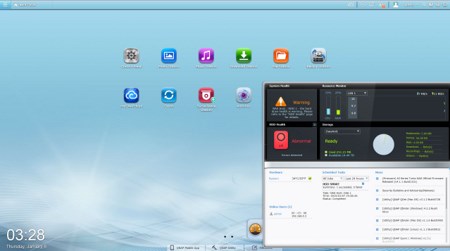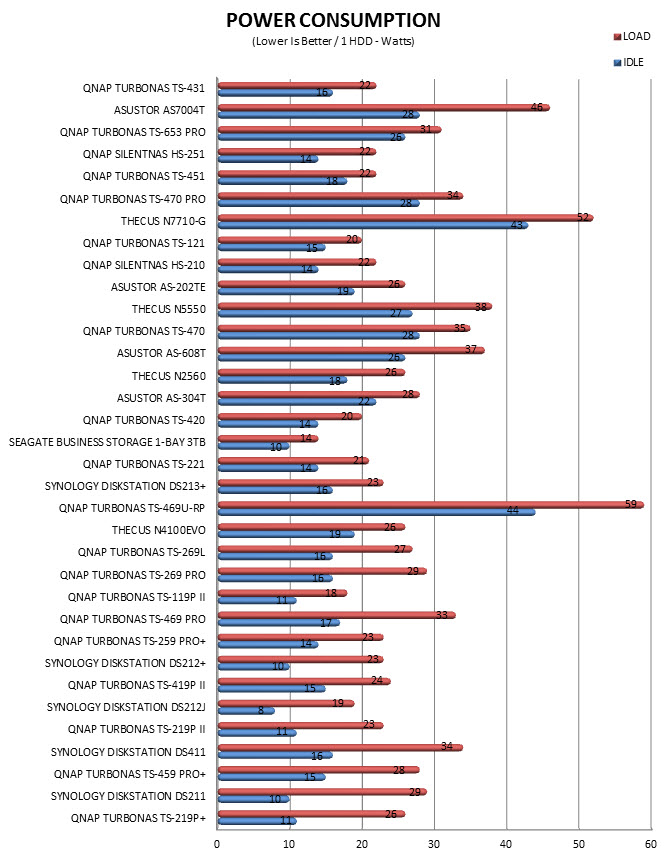INTRODUCTION

It's really a big surprise to all of us the how far NAS devices have gone in the past 3 years alone not only because as we speak most offices and households where we're located own at least one but also because in 2014 alone manufacturers released roughly the same number of new models as they did in the two years prior (2012-2013). We did expect this to happen in the long run since let's face it NAS servers offer many things an HTPC (or even an mITX system) really can't such as size, reduced power consumption, price (depends on the model of course) and out of the box use thanks to the preinstalled OS and the plethora of available (and free) applications. Our focus lately has been on some of the highest-end models to hit the market lately aimed for SMB (small business) use but since many of you asked with us today we have one of the latest low/mid-end NAS servers by QNAP the TurboNAS TS-431.
QNAP Systems, Inc., as its brand promise "Quality Network Appliance Provider", aims to deliver comprehensive offerings of cutting edge network attached storage (NAS) and network video recorder (NVR) solutions featured with ease-of-use, robust operation, large storage capacity, and trustworthy reliability. QNAP integrates technologies and designs to bring forth quality products that effectively improve business efficiency on file sharing, virtualization applications, storage management and surveillance in the business environments, as well as enrich entertainment life for home users with the offering of a fun multimedia center experience. Headquartered in Taipei, QNAP delivers its solutions to the global market with nonstop innovation and passion.
For people looking to get a powerful NAS server are almost always after Intel based solutions but for a low/mid-end model that's not really necessary so QNAP took a different path with the TurboNAS TS-431 since this time over they made use of an ARM Cortex-A9 dual-core 1.2GHz processor by Freescale (1 MB L2 cache) which they paired with 512MB DDR3 RAM and 512MB flash memory. The Freescale ARM Cortex-A9 processor is also responsible for the graphics part (3D/2D) via the embedded graphics processing units by Vivante (GC2000/GC355/GC320) but unfortunately although it does bring support for HDMI v1.4 QNAP didn't equip the TS-431 with a HDMI output (probably due to the relatively low amount of RAM present). Other features include four SATA III/II compatible 3.5"/2.5" Hot swappable drive bays, two Gigabit RJ-45 Ethernet ports, three USB 3.0 ports and one eSATA port. Since however we want to see just how powerful the Freescale AMR Cortex-A9 dual core processor is let's move to the rest of our review.
SPECIFICATIONS AND FEATURES
PACKAGING AND CONTENTS
Just like the TS-451 the TS-431 arrived inside a white box that has a product picture at the front, the company logo, CPU frequency and the main product features.
Moving on the left side we see two small product pictures used to showcase the various parts of the product and a list with the main software features printed in 23 languages.
The unit’s features are printed on the right side right above the available stations.
A proper topology drawing is placed at the rear of the box.
Once again the first thing you’ll notice when you open the box is the thank you message along with 5 2D barcodes (point to QNAPs social media pages) and the contents of the bundle.
The bundle is very basic so aside the TS-431 you will also get the power adapter and cord, two Ethernet cables, two plastic bags with HDD mounting screws and the quick installation guide.
THE TURBONAS TS-431
Again just like with the TS-451 the TS-431 features a hard plastic enclosure that measures 235mm in length, 180mm in width and 177mm in height and weighs 4.56Kg.
As usual small section on the left side of the chassis is perforated allowing hot air to exit.
The design of the fascia is not new so again here we see the on/off power button, one touch copy button, USB 3.0 port and the activity LEDs.
The TS-431 features 4 sturdy drive trays made out of hard plastic which can hold both 2.5" and 3.5" drives.
This time over QNAP has placed the sticker with the quick setup 2D barcode on the right side of the device.
At the rear of the TS-431 we find the 120mm exhaust fan, two GbE ports, two USB 3.0 ports, eSATA port, DC in and a Kensington lock.
Again removing the top cover is very easy just slide the enclosure according to the marks at the bottom (of course after you have removed the rear screws).
Unfortunately due to time restraints we were unable to slice the unit apart but still we did see the heatsink over the Freescale ARM Cortex-A9 processor and what is probably the 512MB NAND flash module by Micron.
SETUP
You can setup the device either through your internet browser or the Qfinder program by QNAP. If you decided to use Qfinder like we do then you should head over to the official support page to download the latest program version.
Through the Qfinder application not only can you find the IP of the NAS but you can also download the latest firmware and start the setup procedure (you will need to choose between quick or manual setup).


You can also setup the preferred RAID mode for the installed drives and upload the latest FW iso.
After you are done with all the settings the process takes less than 5 minutes to complete.
WEB INTERFACE PART 1
The default QTS login screen is filled with nice and colorful pictures.
The GUI screen looks great as always and so at the root screen you will find the icons of the main available/installed stations.


The very detailed resource monitor can be accessed from the lower left corner while a drop down start-like menu can be accessed from the top left corner (again thanks to an tiny incompatibility with our drives although all 4 passed thorough tests the monitor considers one to be “abnormal”).
Once again everything goes through the control panel of the OS.











Via the System Settings menu you can set the name for the server, adjust time, set a password, specify your location, adjust the network IP, play around with power options, set notifications, check the state of the installed drives, create RAID and Virtual drives, enable/disable security settings, configure the speed of the fan, check hardware information, setup backup options, access external device settings, check the logs and of course perform firmware updates.


The Privilege Settings tab is very basic and allows you to create new users, assign those users to groups, setup shared folders, set specific quotas for each user and configure domain security.


From within the Network Services menu you will find everything network-related including FTP settings, Telnet service settings and service discovery settings. You can also setup/configure the Qsync application which allows you to have your files synced between the NAS and your other internet capable devices at all times.


In order to use some of the installed stations you will need to enable them from within the Applications tab.
WEB INTERFACE PART 2
By default the QTS has several applications/stations installed but you can install a lot more from within the App Center.
Via the Photo Station you can see and share all your pictures with other PC and mobile devices.
With the Music Station you can stream and playback your entire music collection without switching to an external application.
One of the things i like about QNAP NAS servers is that you can use the preinstalled Download Station either to download torrent files (check rutorrent if you're interested in this feature) or directly from HTTP/FTP.
As always the File Station allows you to transfer files to and from the NAS and looks quite a bit like the Windows explorer.



The Surveillance Station Pro remains pretty much the same and you can use it with a total of 42 IP cameras from a very large range of manufacturers (even if your camera is not present you can use the several compatibility modes). Although the TS-431 has a license for just two IP cameras still the auto detect (ONVIF) system made up for that.
TESTING METHODOLOGY – PERFORMANCE RESULTS
Originally we had decided that since some of the NAS servers/devices we've tested in the past are no longer in our possession (naturally) we would keep performing the exact same testing methodology we did in the past for as long as possible in order to provide accurate comparison results. However since our real-life tests are not enough for some people we also decided to throw in ATTO and Crystal Disk Mark to cover the more demanding users (it will take time to "populate" those charts however). However as always we will be using Seagate Constellation ES.3 4TB SATA III hard disk drive(s) (in order to also perform RAID tests we were able to switch from the old ES.2 model to the ES.3 since we recorded no differences between them when used inside NAS servers) with the unit at hand and perform several upload/download tests with 10.9GB (Single) and 40,8GB (RAID) files. Tests are repeated a total of 4 times after which we record the average numbers (from the 4 peak ones) into our charts. Finally the network device used is the same Netgear DGN3500 Gigabit ADSL2+ Modem/Router we always use when performing tests on NAS servers (soon we will replace it with a 10GbE Prosafe Switch by Netgear).
SINGLE DISK TESTS



RAID TESTS



TEST RESULTS – TEMPERATURES / CONSUMPTION / NOISE
TEMPERATURES

POWER CONSUMPTION

NOISE LEVELS

CONCLUSION

I don't recall ever testing a NAS server that makes use of a ARM Cortex A9 dual core 1.2GHz processor and since these are usually used in much lighter applications such as media players and tablets i didn't really expect much from it. However although you can tell just by looking at our charts that the TurboNAS TS-431 is no match for most of the Intel based models we've tested in the past still it does extremely well and actually manages to catch up and even surpass several Marvell based models. Of course the onboard RAM also plays a large role in the performance levels of the unit and that actually makes things even more interesting since with just 512MB DDR3 RAM we really didn't expect such results from the TurboNAS TS-431. Also thanks to the Freescale processor power consumption is very low but we can't really say the same for noise levels although the unit did remain relatively inaudible during the majority of our tests. Needless to say the lack of an HDMI port is unfortunate especially since the Freescale processor comes with support for HDMI v1.4 and should be able to produce smooth media playback up to Full HD 1080p resolution.
Performance-wise the latest TurboNAS TS-431 NAS server by QNAP may not be at the top of our charts but with a price currently set at USD333.99 inside the USA (Amazon.com) and at 315Euros inside the EU (Amazon.co.uk) it does over a very good bang for the buck especially for people on a tight budget. Granted the TurboNAS TS-431 would seem like a far better deal to consumers had QNAP placed an HDMI port and perhaps 1GB DDR3 RAM instead of just 512MB but it is what it is and since it does perform very well for its hardware specifications, lacks very few features compared to its higher end brothers and is priced right it gets our Golden Award.

PROS
- Build Quality
- Good Performance
- Features
- 2 Gigabit Ethernet Ports
- 3 USB 3.0 Ports
- eSATA Port
- RAID 0/1/5/6/10/5+Spare
- SATA III (6Gb/s)
- QTS 4.x.x OS
- Price (For Some)
CONS
- No HDMI Port
- Only 512MB RAM

 O-Sense
O-Sense








































.png)

